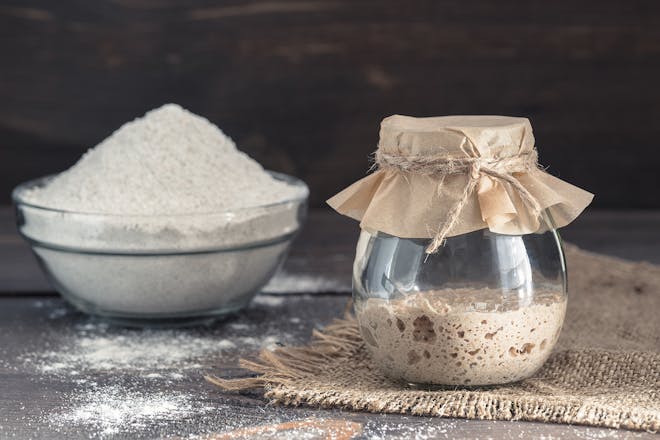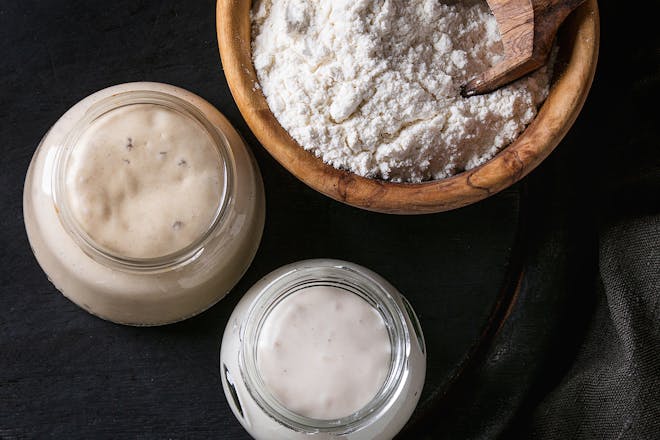How do you make a homemade sourdough starter?

Sourdough is a living material that's been used to make bread for thousands of years. An alternative to commercial baker's yeast, sourdough bread keeps longer and is easier for the body to digest. Here's everything you need to know about making your own natural, homemade sourdough starter.
This page contains affiliate links, which means we may earn a small amount of money if a reader clicks through and makes a purchase. All our articles and reviews are written independently by the Netmums editorial team.
What is a sourdough starter?
A sourdough starter, also known as a levain or mother dough, is a type of leavening agent, a substance that causes fermentation. Used in baking, it's a mixture of flour and water that has fermented thanks to the natural yeasts in the flour and the bacteria in the air, rather than cultivated baker's yeast.
A starter is used to make the dough of sourdough bread rise. Sourdough bread is characterised by its chewy texture, irregular crumb and slightly sour or acidic taste. There are several ways of making sourdough bread, which vary depending on the country or region it's made in, the grains used and the different methods of growing the starter.
The exciting thing about making a sourdough starter is that it's a living thing. Your starter is a breeding ground for good bacteria and needs food and caring for, otherwise it will die.
Once you've made your first starter it can, theoretically, be kept indefinitely. It just needs feeding regularly with flour and water to keep it alive. These feeds are known as refreshments.
For a long time, a sourdough starter was the only way to make bread rise. Legend has it that somewhere in the Mediterranean, someone had made a porridge from grains and water. This was a common meal, sometimes cooked to make flatbread, but they forgot about it and it started to ferment. When it was cooked, they had a risen loaf. So sourdough bread is actually said to have been born out of forgetfulness – good news for absent-minded cooks.
Why makes sourdough so interesting?
The unique, slightly tangy flavour
Sourdough gives bread a pleasant, acidic taste, thanks to lactic and acetic acid produced by the bacteria. It also gives it a rustic, dense and slightly elastic texture. As sourdough starters develop from the bacteria naturally present in the air and in the grains used in the flour, the taste varies according to the flours used, the environment and geographical areas... Each sourdough is unique!
It lasts longer
Sourdough bread lasts longer than bread made with cultivated baker's yeast. The natural acidity means it takes longer to grow mouldy. If you have a busy schedule, you can make one or two large loaves of bread at the weekend and keep them wrapped in a cloth throughout the week.
Its nutritional qualities
Sourdough bread is usually easier to digest and the nutrients in sourdough are more concentrated and easier to absorb. Sourdough is particularly good when made from wholegrains.
The simplicity of ingredients
If you compare the short list of ingredients you use at home to the ingredients in commercially produced bread from the supermarket, you'll soon be convinced that sourdough is the most natural way to make bread.
The satisfaction of saying, 'I made it!'
You can get really good bread from artisan bakers, but it's much more satisfying (and trendy) to make it at home. This is especially true when you're using a fascinating, living material like a sourdough starter.
The older the sourdough gets, the better you'll begin to understand it and its needs. Once you've caught the sourdough bug, you'll be hooked.

Ingredients to make a sourdough starter
Sourdough starters can be made with all kinds of solid ingredients (grated potato or apple, boiled crushed chestnuts ...) and liquids (fruit juices, fermented milk ...), but the simplest, classic starters are made from flour and water:
Flour
To begin your starter, it's best to use organic flour. Strong white bread flour works well, as does rye flour as it's rich in soluble sugars, minerals and enzymes, which are useful for fermentation. For refreshments, organic white strong bread flour is perfect.
Water
It's best to use spring water, or tap water that's been filtered or left in an open jug for a few hours.
Care
You need to care for your starter to ensure it stays alive and active. Some starters can be a bit temperamental and need pampering, while others are easier to look after. Many people give their starters a name as they look after them.
Environment
Starters thrive in mild temperatures and should be kept away from draughts. The temperature in a normally heated house is perfect in winter months. As your starter feeds on bacteria, it's important to avoid keeping it somewhere where it might be exposed to chemical fumes, as this can affect its wellbeing.
Utensils
Mix your flour and water in a clean, well-rinsed container with no traces of washing up liquid. Glass or porcelain are best.
Day 1: Beginning your starter
In a large jam jar or hinged jar with the seal removed, carefully mix 50g of organic rye flour and 50ml of spring water with a wooden spatula. Put the lid on without closing it so that the air can circulate. Place the jar in a place in your kitchen where the temperature is mild, and leave it alone. After about three days it should start to bubble, swell slightly and give off a strong odour. Your starter is born, time to give it a name!
Day 3: The first refreshment
On day three you'll need to refresh your sourdough starter for the first time. Add 50g of organic strong white bread flour and 50ml of spring water. Mix vigorously and put the lid back on as you did on the first day. Put your sourdough back in its place and leave it alone for three days as activity increases.
From day 6: Force feeding
You're now entering the intensive feeding stage. Your sourdough starter needs to be fed twice a day, morning and evening, with an interval of about 12 hours between each meal to make it strong and efficient.
Morning and evening feeds
- Discard most of the starter, you only need to keep around a small coffee cup's worth. This is important as the starter will increase quickly in size – the more you feed it, the more it grows and the more food it needs.
- Put the pot containing the starter on an electronic scale and reset the scale to zero. Add organic strong white bread flour – you need around two to three times the volume of the starter.
- Reset the scale to zero again and add the same weight of spring water as you did flour.
- Mix vigorously with a wooden spatula to aerate the sourdough starter. After several days (the exact time will vary depending on the individual sourdough), the starter will lose its bad smell and become more and more pleasant. After each 'meal', it will double or triple in volume. It's then ripe and ready to use. If you think your sourdough is too weak, give it a drop of organic honey for a few meals. You can also replace the bread flour with rye flour or skip a meal – your sourdough is unique so feed it what you think it needs.

Once your sourdough has reached maturity, it needs to be fed or refreshed regularly to keep it active. There are two methods:
At room temperature: refreshing daily
This method is most practical if you want to make bread or other recipes using sourdough on a regular basis (at least once a week). The starter is left in its jar in a temperate corner of the kitchen and fed every morning (it only takes a few minutes):
- Stir your starter with a wooden spoon
- Remove a large amount of the starter*, leaving the equivalent of two tablespoons.
- Add 60g of flour and 60ml of spring water. Use strong white bread flour, you can swap this for rye flour once in a while to give your starter a feast. Mix vigorously for 30 seconds. Scrape off the edges so that all the starter is at the bottom of the pot.
- Put the lid back on without closing it. Watch your sourdough starter throughout the day.
In the fridge: refreshed when needed
If you don't bake regularly, keep two tablespoons (about 20g) of your starter in a jam jar at the bottom of the fridge so that it can sleep. It doesn't need to be fed, a bit like a hibernating animal. When you need it, proceed as follows:
- Take the starter out of the fridge and let it wake up for two hours at room temperature.
- Add 60ml of spring water and mix.
- Add 60g of strong white bread flour and mix again vigorously for about 30 seconds.
- Eight to 12 hours later, your starter should have regained its strength. If it's been in the fridge for a long time, it may need a couple more meals to truly wake up. If it looks a bit tired, feed it once or twice more using the same method, keeping only two tablespoons of sourdough each time.
* Wondering what to do with the discarded starter? You can: 1) throw it away, but that seems a shame; 2) keep it in a cool place and make crumpets when you have enough; 3) give it to a friend who wants to make their own sourdough and skip the 'creation' stage.
What can you do with a sourdough starter?
Bread
Making bread with your sourdough starter is quite straightforward, but it does require a bit of organisation. The starter has to be prepared in advance and it takes longer for the bread dough to rise than it does with industrial baker's yeast. The result is definitely worth the effort, though. To get started, take inspiration from the following recipes, and then develop your own according to the 'character' of your own sourdough starter:
- Try this simple sourdough bread recipe. Along with your starter, the only ingredients you need are strong white bread flour and some wholemeal, rye or spelt flour, tepid water and salt.
Other recipes
- This sourdough crumpets recipe is a great way to use up the excess sourdough removed when refreshing your starter. Made using no fat or eggs, it takes just 15 minutes from start to finish. You can also try English muffins, pretzels or sourdough breadsticks.
- You can use sourdough to make cakes, Yummly have collated a great selection of sourdough cake recipes including chocolate, coffee and blueberry.
- Finally, try these sourdough crackers with olive oil and herbs or add any sourdough discard to a basic batter recipe to make extra-tasty pancakes or Yorkshire puddings.
Interested in making bread at home - but busy parent life keeps getting in the way? Why not invest in this practical bread maker? With a computer memory that does all the hard work for you, it can prepare anything from doughs for bread rolls, pizza and it even has gluten free options. Perfect for busy households! See more details at Morphy Richards.
Looking for recipe inspiration, want to share your kitchen tips or have any cookery questions? Chat everything food in the forum below.
Related stories
15 ingredient substitutes for baking and cooking

